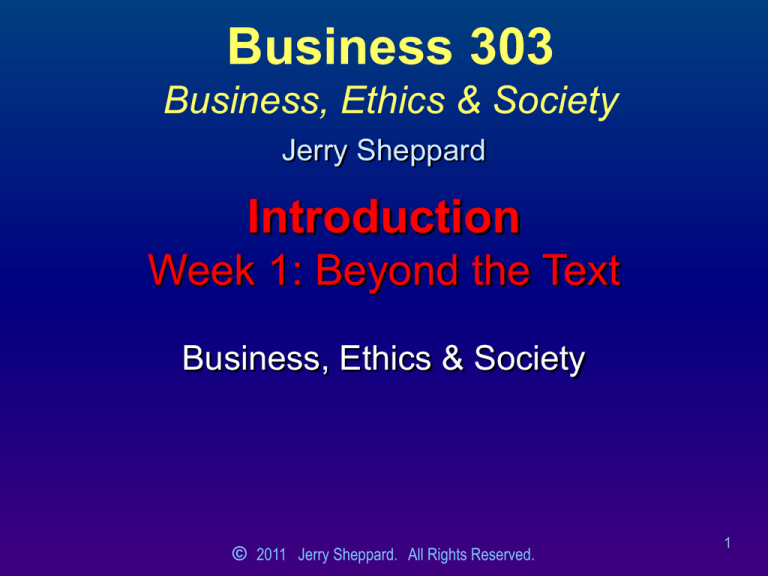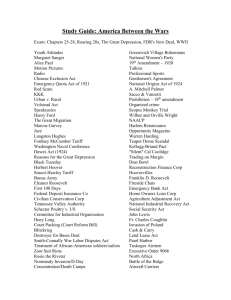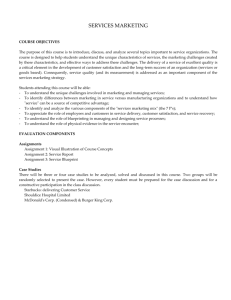
Business 303
Business, Ethics & Society
Jerry Sheppard
Introduction
Week 1: Beyond the Text
Business, Ethics & Society
© 2011 Jerry Sheppard. All Rights Reserved.
1
Beyond the Text
I.
II.
III.
How we Broke the World
Brook’s Business Ethics in Canada
Stone’s Where the Law Ends
2
I. HOW WE BROKE THE WORLD
Change in Regulation
Sen. Phil Gramm (R, Texas),
Rep. Jim Leach (R, Iowa), &
Rep. Tom J. Bliley, (R, Va.)
Sen. Carter Glass (D-Va.) and
Rep. Henry B. Steagall (D-Ala.),
Co-sponsors of the 1932 Glass-Steagall Act.
Co-sponsors of the 1989
Gramm–Leach–Bliley Act.
• The Glass-Steagall Act in the early 1930s stabilized the
U.S. banking system, protected depositors, and restricted
bank activity out of the securities and insurance industries.
• The Gramm–Leach–Bliley Act ended Glass-Steagall
and allowed banks the opportunity to enter the
securities and insurance industries.
3
Early Warnings
The case for preserving the Glass-Steagall Act
included the following arguments.
•Conflicts of interest characterize the granting of credit - lending
- & the use of credit - investing - by the same entity.
•Depository institutions enormous power… must be limited to
ensure soundness and competition in the market for funds.
•Securities activities can be risky, leading to losses that may
threaten the integrity of deposits government insures & may be
required to pay in the face of collapse from such losses.
•Deposit institutions are supposed to be managed to limit risk.
The managers thus may not be conditioned to operate
prudently in more speculative securities businesses.
William D. Jackson to Congress Specialist in Financial Government & Finance Division, in 1987.
4
What the banks did
• The banks moved into insurance and securities
business, as the law now allowed.
• Banks also became involved in a range of new
investments. Of major concern should have been:
– Mortgage Backed Securities (MBSs) – essentially
bonds that have real estate assets as collateral.
– Credit Default Swaps (CDSs) – basically insurance
against a loan going bad (actually a bet).
• EXCEPT a CDS can be written for an investment you do not
own, or can be written several times over.
– Concept of Too Big to Fail – The notion that a bank is
too big to fail and that in the event of major losses the
government will bailout the institution to prevent general
5
economic collapse.
What Happened
• The banks would issue mortgages, many of
which were loans to high credit risks on
overvalued property.
• The mortgages were then bundled together
as collateral for mortgage backed securities
and sold to unsuspecting investors.
• They then created Credit Default Swaps on
the Securities that were likely to go bad.
• Insurance companies invested the money
they made on CDSs in MBS that were bad.
• The banks forgot everyone else might issue
bad MBS and also invested in them.
6
The Problem
• As mortgages went bad, foreclosures rose, put
homes on the market & depressed housing prices.
• As housing prices dropped, it made sense for folks
to walk away from their upside down homes.
• This made more bad MBSs & more CDS payouts.
• Insurers like AIG thus did not have the cash to
payout on CDSs & the government had to step in
to prop up insurers & banks with bad MBSs.
• The banks now had no incentive to lend since it
made more sense to deny a loan & bet on a CDS
that the company would fail (e.g. G.M.s bankruptcy).
• Hence, Theft of public funds for private use and the
7
slow recovery in the U.S.
The Point: Adverse Selection & Moral Hazard
• The result is that there is a market failure in the
form of Adverse Selection and Moral Hazard.
Adverse Selection
Moral Hazard
General
Definition
Information is hidden from Hidden actions occur
the insurer prior to the
after the transaction that
transaction.
are costly to the insurer.
Volvos
Reckless drivers are more Once you own a Volvo you
likely to buy Volvos.
will drive more recklessly.
All you can eat Big eaters are more likely Once you’re in, it makes
restaurants
to go to these restaurants. sense to overeat.
BANKS
Banks who write bad loans Knowing you are too big to
are more likely to seek out fail & the government will
Credit Default Swaps.
bail you out, you are more
likely to write bad loans. 8
II. Brook’s BUS. ETHICS IN CANADA
• Business in Canada has not been subject, to a
powerful national institutional framework such as
the US Securities and Exchange Commission &
the Foreign Corrupt Practices Act.
• Consequently, business ethics in Canada have
developed primarily in response to broader sociopolitical and socio-economic factors than in the
US, and will probably continue to do so.
• The issues, policies and practices developed in
Canada may provide insights for US corporations
as they respond to broadened pressures.
9
Pressures from responsible investors
• Social Audits for Corp. Social Performance
• Task Force on Churches & Corp. Resp. (TCCR)
– Issues put before management included: Apartheid in
South Africa, human rights, military exports, international
lending, corp. disclosure, aboriginal issues, environmental
protection, corp. governance, and responsible investment.
• Ethical Mutual Funds & large responsible investors.
10
Pressure from directors & consultants
• Directors insuring Long Run Profitability by
insuring sustainability, human resource equity.
• Groups like EthicScan & Corp. Ethics Monitor.
• Canadian Centre for Ethics & Corp. Policy (CCECP)
– Provided forums for discussion of ethical issues.
• Centre for Corp. Social Performance & Ethics (U of T)
– A university-based centre which undertakes both academic
research and consulting to business.
– Collects & computerizes corp. code data, provides consulting services on creation / revision of ethics codes, develops
training programs, analyzes corp. governance systems,
– The Centre organized invited conferences on “Stakeholder
Theory & the Management of Ethics in the Workplace.” 11
III. Stone’s WHERE THE LAW ENDS
Christopher D. Stone. 1975. Where the Law
Ends: The Social Control of Corporate Behavior.
New York: Harper & Row, Publishers, 273 pages.
•Much of my review summarizes D. L. Arthur, 1976,
Administrative Science Quarterly, 21 (2): 356-358.
•Basically this book is a good introduction into what
the Law is, and is not, capable of doing to control
corp. behaviour in the public’s interest.
•Written early on in the development of the area of
“Social Issues in Business,” the book directed
academics and practitioners toward more detailed
suggestions toward good governance.
12
Stone Summary (1 of 2)
• In Dartmouth vs Woodward (1819) the U.S. Supreme
Court declared: "A corp. is an artificial being,
invisible, intangible, and existing only in
contemplation of law.”
• Subsequent to that decision most theories, policies,
and laws pertaining to corporations consistently have
acknowledged the "being" quality of corporations and
ignored the "artificial.”
– This is reflected in contemporary
theories & laws which assume
corporations respond to econ. &
legal incentives in a manner
similar to individuals.
Stone Summary (2 of 2)
• Stone develops the notion that corporations are not
people & there are important differences between
human & artificial beings.
– Stone's theme is that social incentives which effectively
channel the behavior of individuals in a socially desirable
direction are not effective in channeling the behavior of
corporations.
• The intellectual significance here is that he focuses
attention on an important, but neglected, area of
social inquiry: the influence of external forces on the
conduct of corp. members.
14
Stone: Part 1 of 4
Corporations & the Law Develop – But Not Apace
• The first four chapters look at the division that has
occurred in the evolution of the corporate form and
the legal environment intended to control it.
• In the first chapter Stone notes:
– ”the law ought constantly to be searching out and taking into account
the special institutional features of business corporations that make the
problems of controlling them (and… men-in-them) a problem distinct
from that of controlling human beings in ordinary situations."
• The next 3 chapters detail how early corp. law failed
to distinguish between human and artificial beings.
– So by the end of the 1800s there was a widening gap between what the
law needed to consider to impact corp. behaviour & what it did
15
consider.
Stone: Part 2 of 4
The Historical Legacy
[& more recent legal approaches to social control of the corp.]
• Mixing behavioral sci. & case law, Stone notes why
efforts to control the corp. & its members have failed.
• Laws have not taken into account "special institutional
features" of the corp. not applicable to human indiv.s.
– For example human beings may be influenced by feelings
of shame & guilt and by external controls such as prison.
– Corp.s are unaffected by traditional social control techniques
16
Stone: Part 2 of 4
The Historical Legacy (Continued)
[& more recent legal approaches to social control of the corp.]
• Considerations of the good a Corp. can do
may be weighed against punitive measures
& a corp. goes unpunished (MER/29).
– This has changed somewhat
(e.g. A.H. Robins, Johns Manville).
• Criminal Penalties aimed at individuals are
difficult to pursue because identifying a
truly purposeful actor who may have
committed the wrong within the Corporation
is difficult.
17
Stone: Part 3 of 4
The Corporate Social Responsibility Debate
• Stone considers, in succession: efficacy of "markets"
& then "responsibility" in controlling corp. conduct.
• Through careful analysis of actual corp. behaviour
Stone looks at how the "market" is unable to protect
against corp. mis-conduct (e.g. its reactive nature &
information asymmetries).
– He concludes that "responsibility" is necessary because the
law & the market are inadequate controls.
• This conclusion is the opposite of that held by Milton
Friedman (who believes corp.s need not be socially responsible since they are constrained by the law and the market).
– More on this later in the term.
18
Stone: Part 4 of 4
Controlling Corporations: Putting the Model to Work
• Stone makes suggestions which should result in
more effective social control of corp. misconduct.
• Corp. should be considered distinct from its members.
• Corp. behavior is best understood from a process
point of view rather than as individual behavior.
– To control the corporation one must control the process.
• To this end he suggests changes in:
– the composition & responsibilities of certain corp. directors,
– public access to corp. info. of public consequence, and
– direct public monitoring of corp. activities in situations
where there is the likelihood of corporate misconduct.
• Stone’s recommended reforms are suggestive rather
than definitive, but are logical derivatives of analysis.
Stone Conclusion
• “If one considers only the narrative in each of the 4 parts it is quite
possible that the essence of the book will be over-looked.
– “Each of the 4 parts is interesting, well organized, & thought provoking.
However…
20
Stone Conclusion
• “However, the lasting achievement of the book is its insightful
glimpse into the complexities of the interrelationship between the
external and internal environments of the corporation.
– “From the studies of law and economics one can obtain a conceptual
understanding of the external environment of the corporation.
– “From the study of organizational theory and behavior one can acquire
insight into the internal dynamics of the corporation.
• “What Professor Stone's book does is suggest a new field which
examines the interface [of business and Society].”
D. L. Arthur, 1976, Administrative Science Quarterly, 21 (2): 358.
• That field became the study of governance & ethical behaviour
within the business organization: Business, Society & Ethics.
End




